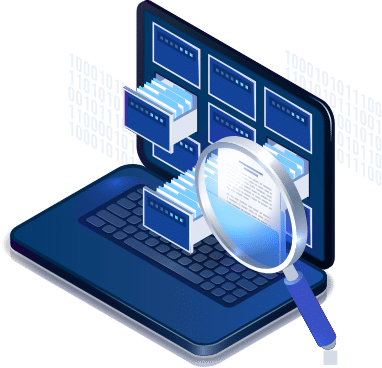Imagine walking into the world’s largest library where millions of manuscripts are stored – but there’s no catalog. Somewhere in that sea of information lies exactly what you need, but without organization, it’s impossible to find.
This is what happens when companies collect massive amounts of data but lack the right strategy to manage it. As businesses generate more information than ever before, traditional databases and data warehouses struggle to keep up. That’s where data lakes come in.
What is a Data Lake?
A data lake is a centralized repository that stores vast amounts of structured, semi-structured, and unstructured data in its raw form. Unlike traditional databases or data warehouses, which require data to be pre-processed and structured before storage, data lakes allow businesses to ingest data first and structure it later based on their needs.
This flexibility makes data lakes a powerful solution for organizations dealing with large-scale data from diverse sources, including (but not limited to):
- Transactional systems (e.g., sales records, financial transactions)
- Customer interactions (e.g., support tickets, website behavior)
- IoT and sensor data (e.g., smart devices, industrial monitoring)
- Social media and logs (e.g., clickstream data, server logs)
Data Lake vs. Data Warehouse: How Do Data Lakes Differ from Traditional Databases?
| Feature | Data Lakes | Traditional Databases & Data Warehouses |
| Data Structure | Raw, unstructured, semi-structured, and structured | Highly structured, predefined schema |
| Storage Cost | Lower (cheap cloud/object storage) | Higher (specialized data storage and processing) |
| Processing Approach | Schema-on-read (structure data when needed) | Schema-on-write (structure data before storage) |
| Scalability | High (handles petabytes of data) | Limited by predefined schema and storage |
| Use Case | Advanced analytics, AI/ML, real-time insights | Operational reporting, predefined queries |
What are the Advantages of Data Lakes?
Data lakes are a modern solution that offers unlimited storage, flexibility, and the power to fuel AI-driven insights. When properly implemented and managed, data lakes open a world of opportunities for analytics, innovation, and competitive advantage. Some of their key advantages include:
1. Scalability and Flexibility
One of the most standout benefits of data lakes is their ability to scale. Traditional data storage systems struggle with large, diverse datasets, especially as businesses grow. In contrast, data lakes provide virtually unlimited storage capacity. Whether you’re storing terabytes or petabytes of data, a data lake can handle it all.
Another advantage of data lakes is flexibility. As mentioned earlier, these data repositories can store structured data (e.g., tables from relational databases), semi-structured data (e.g., JSON or XML), and unstructured data (e.g., images, videos, or logs).
This diversity allows companies to aggregate and store all types of data in one centralized location and eliminates the need for multiple systems and the complexity of data silos. Moreover, data scientists can experiment with different models and techniques without the constraints of rigid data structures.
This flexibility is why data lakes are widely adopted in industries like finance, healthcare, retail, and manufacturing, especially by companies looking to leverage big data.
2. Advanced Analytics and Machine Learning
Data lakes are designed with advanced analytics in mind. This enables organizations to apply machine learning, artificial intelligence, and big data analytics to raw data. Since data is stored in its raw, untransformed state, businesses can:
- Perform complex analyses without worrying about the need for predefined schemas.
- Build predictive models by analyzing data from multiple sources (e.g., customer behavior, market trends, IoT data).
- Use real-time analytics to extract insights instantly, empowering quicker decision-making.
3. Cost-Effectiveness
Data lakes are typically built on cheap, scalable storage options, especially when utilizing cloud platforms such as AWS, Azure, or Google Cloud. The cost per gigabyte of storage is significantly lower than that of traditional databases or data warehouses.
Moreover, data lakes eliminate the need for data transformation and cleansing before ingestion. These factors make data lakes an economical choice for businesses with tight budgets or large volumes of raw and unprocessed data.
4. Faster Insights
Since data lakes allow businesses to ingest and analyze data in its raw form, organizations can extract valuable insights faster. Moreover, since data lakes facilitate the use of real-time analytics, companies can continually track performance metrics, customer interactions, or market trends, providing immediate feedback loops for quicker decision-making.
With the right tools and processes in place, organizations can also reduce time-to-market for new products, services, and innovations.
5. Data Democratization
One of the most impactful benefits of data lakes is data democratization – the ability to make data accessible to a wider range of employees across the organization.
In traditional data systems, access to information is often restricted to IT teams or data specialists. However, in a data lake, raw data is stored in an open format, which allows users (even non-technical ones, such as from marketing, sales, and operations teams) to explore, analyze, and derive insights from the data without needing advanced technical expertise.
This increased accessibility improves collaboration across departments and help to align company-wide goals. As a result, businesses can leverage the collective knowledge and creativity of their entire workforce to identify new opportunities and optimize operations.
6. Improved Data-Driven Decision Making
By consolidating all forms of data in a single repository, data lakes allow organizations to access a comprehensive view of their operations, customers, and market environment. For companies leveraging a customer data platform, integrating it with a data lake allows for richer insights, providing a holistic view of customer interactions across various channels. This 360-degree perspective enables businesses to:
- Make data-driven decisions with a deeper understanding of customer needs, preferences, and behaviors.
- Utilize historical data for trend analysis and forecasting.
- Apply cross-functional insights, combining sales, marketing, and customer support data for more integrated strategies.
While data lakes offer immense potential for businesses, they are not without their challenges. Without proper planning and management, data lakes can quickly turn into “data swamps,” which are disorganized, messy, and nearly impossible to extract value from – basically useless. Let’s explore some of the biggest challenges businesses face when implementing a data lake.
Challenges of Implementing Data Lakes
Below are the key challenges organizations face when implementing data lakes:
1. Data Quality & Governance Issues
Data lakes store vast amounts of data, but without strong governance, free-flowing information ingestion can lead to:
- Inconsistent formatting (e.g., different date formats across datasets).
- Duplicate records (e.g., multiple entries for the same customer with slight variations).
- Unverified or unclean data, which makes analytics unreliable.
Without data quality controls and a clear metadata management strategy, businesses may struggle to extract meaningful insights from their data lakes.
2. Integration Complexities
Ingesting data from multiple sources can also create significant integration challenges. Organizations often need to:
- Connect legacy systems, modern applications, and third-party data streams.
- Standardize and harmonize diverse data formats (structured, semi-structured, and unstructured).
- Maintain real-time or batch data processing without performance bottlenecks.
Poorly integrated data can lead to data silos within the data lake itself, which defeats its purpose as a unified repository.
3. Security & Compliance Risks
Because data lakes also store sensitive information, they pose significant security and compliance risks if not properly managed. Without measures like role-based access controls, encryption, and auditing mechanisms, businesses risk exposing confidential information to unauthorized users, which can lead to compliance violations and potential data breaches.
4. Performance & Querying Difficulties
Unlike traditional databases optimized for fast querying, data lakes can suffer from slow performance if not properly structured. Organizations often face:
- Inefficient data retrieval due to lack of indexing.
- Complexity in querying large, raw datasets.
- High processing costs when running analytics on un-optimized data.
To avoid these issues, companies need to implement data partitioning, indexing strategies, and metadata management to enhance accessibility and performance.
Best Practices for Implementing a Successful Data Lake
A well-designed data lake can be a game-changer for businesses, but without the right strategies, it can easily become a disorganized, inefficient data swamp. To maximize the benefits of a data lake and avoid common pitfalls, organizations should follow these best practices:
1. Define Clear Data Governance Policies
Data governance is the foundation of a successful data lake. As mentioned above, without a structured approach to managing data, businesses risk dealing with inconsistent formats, duplicate records, and unreliable analytics. Organizations should establish governance policies that include:
- Metadata management – Tagging data with descriptions, categories, and relationships to improve discoverability. Frameworks like Apache Atlas and Collibra can help automate metadata management and lineage tracking.
- Access control – Restricting data access based on user roles to enhance security. Role-based access control (RBAC) tools such as Okta and Privacera ensure compliance while maintaining flexibility.
- Data lineage tracking – Maintaining records of data sources, transformations, and usage to ensure transparency. Tracking data lineage with tools like Talend and Alation helps organizations understand how data flows and evolves over time.
- Quality and retention rules – Setting guidelines for data validation, standardization, and retention timelines.
A well-governed data lake enables better data organization, security, and usability while ensuring compliance with regulatory requirements.
Measuring Governance Success
Businesses should track key metrics to evaluate the effectiveness of their data governance strategy. The key ones include:
- Percentage of duplicate records removed – A high percentage reduction indicates improved data quality.
- Data freshness score – Measures how up-to-date the data is and ensures relevance for analytics.
- Access control compliance rate – tracks unauthorized access attempts and adherence to security policies.
- Metadata completeness percentage – Ensures that data is well-documented and easily discoverable.
A well-governed data lake enables better data organization, security, and usability while ensuring compliance with regulatory requirements.
2. Invest in Data Quality & Matching Tools
A data lake is only as valuable as the quality of the data stored within it. Poor data quality leads to inaccurate analytics and unreliable business insights. Investing in powerful data quality tools, such as DataMatch Enterprise, helps organizations:
- Profile and clean raw data to identify inconsistencies, missing values, and errors.
- Standardize and normalize data to maintain uniformity across different data sources.
- Match and deduplicate records to ensure a single source of truth.
- Enrich datasets by linking related data points from multiple sources.
By ensuring high data quality from the start, businesses can maximize the effectiveness of their data lake and generate accurate, actionable insights.
3. Implement Tiered Storage & Indexing Strategies
A data lake should be designed for efficiency, balancing performance and cost-effectiveness. One way to achieve this is by implementing tiered storage:
- Hot storage – Stores frequently accessed data in high-speed storage (e.g., SSDs, in-memory databases).
- Warm storage – Keeps semi-active data in cost-effective storage options with moderate retrieval speeds.
- Cold storage – Archives older or infrequently used data in low-cost storage solutions (e.g., cloud object storage, tape backups).
Additionally, indexing strategies (such as partitioning large datasets or using optimized file formats like Parquet or ORC) can enhance query performance and reduce processing times.
4. Ensure Strong Security & Compliance Frameworks
Since data lakes often store sensitive business and customer data, organizations must implement strict security measures to prevent unauthorized access and ensure compliance with industry regulations such as GDPR, HIPAA, or CCPA.
Key security best practices include:
- Role-based access control (RBAC) – Granting permissions based on user roles and responsibilities.
- Encryption – Protecting data at rest and in transit using strong encryption methods.
- Audit logs – Tracking access, modifications, and usage patterns to monitor security risks.
- Automated compliance monitoring – Continuously scanning data to ensure adherence to regulatory standards.
By prioritizing security and compliance, businesses can mitigate risks and maintain customer trust while maximizing the value of their data lake.
5. Leverage AI & Automation
Managing a large-scale data lake manually is inefficient and prone to errors. By incorporating AI and automation, organizations can:
- Automate data ingestion and classification – AI-powered tools can categorize, tag, and structure incoming data for easier retrieval.
- Detect anomalies and inconsistencies – Machine learning models can flag unusual patterns in data quality and integrity.
- Optimize data lifecycle management – Automated workflows can archive, delete, or move data based on predefined rules.
- Enhance real-time analytics – AI-driven engines can process and analyze streaming data for faster decision-making.
Automation and inclusion of AI can help businesses streamline data management processes, improve operational efficiency, and extract deeper, more meaningful insights from their data lakes.
The Future of Data Lakes and Their Role in Business
As businesses continue to generate vast amounts of structured and unstructured data, data lakes are evolving to address new challenges and opportunities. The following trends are shaping the future of data lakes:
1. Rise of Data Lakehouses
The convergence of data lakes and data warehouses into data lakehouses is gaining momentum. Companies like Databricks and Snowflake are leading the trend by providing unified platforms that combine the flexibility of data lakes with the structured performance and reliability of traditional data warehouses. These solutions enable businesses to seamlessly store, process, and analyze massive datasets with improved efficiency and governance.
2. AI-Powered Data Management
Machine learning and AI are playing a bigger role in optimizing data lakes. Automated data cataloging (e.g., with Informatics CLAIRE), anomaly detection, and self-healing data pipelines are becoming essential for maintaining high-quality and well-structured data.
3. Increased Focus on Data Privacy and Compliance
With stricter regulations and evolving AI governance frameworks, businesses must ensure that their data lakes comply with strict governance, security, and privacy policies. For this reason, the future of data lakes will involve more automated governance tools and compliance checks and better access control mechanisms to protect sensitive data.
4. Real-Time Data Processing
Companies are increasingly moving toward real-time data processing to stay competitive. Instead of relying on historical batch processing, modern data lakes now support real-time analytics, streaming data ingestion. This enables organizations to process data more efficiently and supports instant decision-making.
For example, in finance, real-time data processing is crucial for fraud detection – it allows banks to identify suspicious transactions as they occur. In e-commerce, businesses use real-time analytics to deliver personalized recommendations, which optimizes customer experience and boost sales.
5. Interoperability and Multi-Cloud Data Lakes
As enterprises adopt multi-cloud strategies, data lakes must be interoperable across different platforms such as AWS, Azure, and Google Cloud. Businesses are shifting towards cloud-agnostic architectures that allow seamless data sharing and processing across multiple environments.
Make the Most of Your Data Lake
Data lakes have transformed how businesses store and manage vast amounts of data. When implemented correctly, they offer scalability, flexibility, and the ability to drive advanced analytics and AI initiatives. However, without proper governance, quality control, and security measures, a data lake can quickly turn into an unusable data swamp.
Businesses that invest in automated data cleansing, matching, and deduplication tools can ensure their data lake remains a high-value asset rather than an overwhelming challenge. This is where DataMatch Enterprise (DME) can help.
As an industry-leading data matching solution, DME enables organizations to:
- Remove duplicates and inconsistencies in raw data
- Ensure clean, standardized, and high-quality data
- Improve data accessibility and reliability for analytics and AI-driven insights
By combining a well-structured data lake architecture with powerful data quality solutions like DataMatch Enterprise, businesses can drive better decisions, enhance customer insights, and gain long-term competitive advantage.
Are you ready to optimize your data lake for maximum impact? Schedule a consult with an expert today to discover how DataMatch Enterprise can help.










































